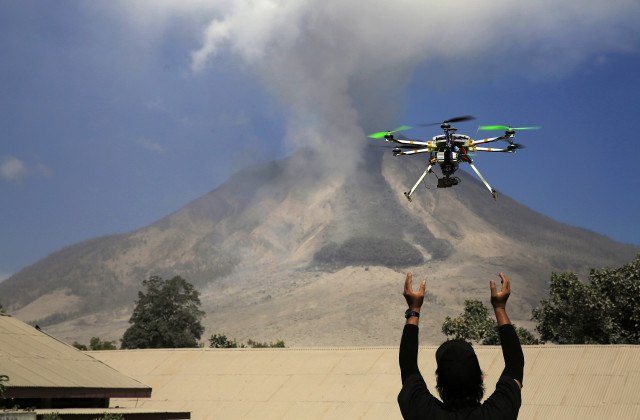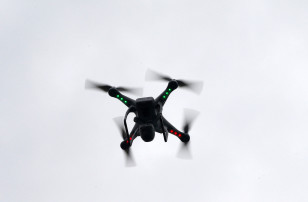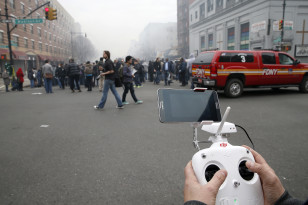
An official of the Center for Research and Technology Volcanoes Development (BPPTK) releases a drone quadcopter to monitor activity from Mount Sinabung volcano at Sibintun village, North Sumatra province in Indonesia, Feb. 4, 2014. (Reuters)
Unmanned Aerial Systems (UASs) just getting off the ground in commercial and private space are already running into some challenges. But concern surrounding their use has not stopped at least one humanitarian group from putting them to work for disaster relief operations.
Drones or unmanned aerial vehicles (AUVs), as they are sometimes called, “have a bad rap,” says Andrew Schroeder, Director of Research and Analysis at the humanitarian and medical non-profit Direct Relief.
The word “drone” has been typically associated with unmanned aircraft used by the U.S. military. But Schroeder says there are many types of unmanned aircraft that people might not be “terribly informed” about.
Computer Science and Engineering Professor Robin Murphy, Director of the Center for Robot-Assisted Search and Rescue, says models used by the military include high altitude long endurance (HALE), medium altitude high endurance (MALE), and small/micro planes, which tend to be inexpensive.
The Huygen X1 is one of the smaller models reconfigured for use when typhoon Haiyan slammed the Philippines last year.
As Schroeder describes it, the aircraft is a “quadcopter drone that has high resolution cameras, thermal imaging and is sort of ruggedized, so it’s got sort of extra powerful motors so it can fly in wind and rain. And the body is reinforced so that if it crashes, it doesn’t break.”
He says the plane has been “very effective” in photographing remote areas, sighting camps established by homeless residents and identifying blocked and accessible road networks. While satellites also perform these tasks, Schroeder says drones are effective in areas that get a lot of rain because they fly “underneath the cloud cover” while providing very precise images.

A camera drone flown by Brian Wilson flies near the scene where two buildings were destroyed in an explosion, in the East Harlem section in New York City, March 12, 2014. (Reuters)
But Murphy cautions that unmanned aircraft flying at low altitudes in disaster situations, when countries often close their airspace to all air traffic, could endanger the lives of responders on the scene. She says one of the reasons the airspace is closed is to “allow helicopters to fly dangerously low to search and hoist up victims or drop off supplies.”
“The helicopters are flying at 200 feet, which means a collision with a bird could cause [them] to crash,” she said. And if a manned helicopter sees an unmanned system, they “have to abort their mission – which means the people being rescued are not being rescued,” she added.
Murphy says she has seen footage of NGOs flying UASs directly over refugees, a move she describes as “very risky,” particularly with cheaper devices which “have far less reliability and safety features than ones built for the military and civilian public sector markets.”
She says there have been numerous accidents with these types of aircraft “where people have been hurt.”

Brian Wilson flies a camera near the scene where two buildings were destroyed in an explosion, in the East Harlem section in New York City, March 12, 2014. (Reuters)
“If anything breaks, the wind gusts, or the wireless fails, this can crash faster than the pilot [i.e., the person remotely controlling the aircraft] can react. And the blades often don’t have auto cutoff. So they spin like weedwackers until they fall apart,” she said.
And in conflict situations, the unmanned aircraft runs the risk of being shot down.
Nevertheless, Murphy acknowledges the “many good humanitarian uses” that UASs fill and predicts that they will become more prevalent among relief workers and journalists.
“I’m particularly impressed with Matternet which is exploring how small UASs can safely and reliably carry medicine and samples to mountainous regions of countries where the roads get cutoff for months at a time due to flooding,” she said.
The technology is still young, adds Schroeder, although he too expects UASs to have more uses as people become more familiar with them. He envisions a future where unmanned aircraft are standard equipment for workers in remote areas, allowing them to mount a more integrated response and send equipment, supplies or messages to people affected by disasters.
“We support health workers that are … in some of the most remote parts of the world and they are hamstrung by logistics issues on a daily basis,” he said. “And when we can end-run those and not have to do things like build new roads but still get vaccines to places where we need to conduct vaccination campaigns … that makes a huge difference to the lives of some of the poorest people in the world.”
But this will take time in countries that have experienced UASs as tools of war. In other countries, Schroeder expects a “rapid advance of some uses of this kind of technology.”
It would also help to stop referring to these aircraft as drones.
“The correct term,” says Murphy, “is unmanned aerial systems or UAS.”
The discussion is already underway. And Schroeder has initiated a United Nations group called NetHope that links technology companies and NGOs around technology issues. He is hopeful that there will be a “lot of change in the discussion around policy, technology and humanitarian relief as far as UAVs are concerned over the next year.”

2 responses to “Aid Groups Turn to Unmanned Aircraft for Disaster Support”
[…] Read the full article… […]
[…] //blogs.voanews.com/techtonics/2014/05/09/aid-group-tests-unmanned-aircraft-for-disaster-suppor… […]